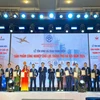Major export industries need to join in global distribution chains, improve the quality of their products, and develop recognised global trademarks if they are going to boost their competitive capacity and see sustainable export growth, says Pham Van Chat, an expert with the Ministry of Industry and Trade.
The ministry has been actively promoting Vietnamese products to major European supermarket chains, seeking to enter these markets more aggressively via their distribution networks, Chat said.
Meanwhile, major export industries report that they continue to face challenges to sustainable development.
Despite seeing annual growth in exports as high as 20 percent per year, the garment industry continues to face challenges, including inefficient production and unstable markets and financial resources, said the deputy general secretary of the Vietnam Textile and Garment Association, Nguyen Van Tuan.
Garment makers have often focused on maintaining jobs in the sector but not on improving processes, while Chinese and Japanese garment makers have developed more efficient production lines, Tuan said.
Domestic garment makers have also failed to develop strong support industries and local suppliers of cotton and fibres, he said.
The wood products industry has seen annual export value jump from 219 million USD in 2000 to 3.9 billion USD in 2011, but the industry still remains unprofessional and uncoordinated, suggested HCM City Fine Arts and Wood Processing Association vice chairman Tran Quoc Manh.
Nearly the entire industry consists of small- and medium-sized enterprises with unskilled workers and low output, Manh said.
The industry has also had difficulties in obtaining materials and are forced to import up 70 percent of their raw materials to meet demand, he added.
The seafood industry, despite exports exceeding 6 billion USD in 2011, has faced a similar problem in sourcing quality raw materials for processing and was also grappling with anti-dumping cases and strict quality standards in export markets though the industry, said Vietnam Association of Seafood Exporters and Producers (VASEP) general secretary Truong Dinh Hoe.
The domestic seafood industry needs more assistance from the Ministry of Agriculture and Rural Development to ensure supplies of raw materials that ensure the quality and hygiene of processed products, Hoe said.-VNA
The ministry has been actively promoting Vietnamese products to major European supermarket chains, seeking to enter these markets more aggressively via their distribution networks, Chat said.
Meanwhile, major export industries report that they continue to face challenges to sustainable development.
Despite seeing annual growth in exports as high as 20 percent per year, the garment industry continues to face challenges, including inefficient production and unstable markets and financial resources, said the deputy general secretary of the Vietnam Textile and Garment Association, Nguyen Van Tuan.
Garment makers have often focused on maintaining jobs in the sector but not on improving processes, while Chinese and Japanese garment makers have developed more efficient production lines, Tuan said.
Domestic garment makers have also failed to develop strong support industries and local suppliers of cotton and fibres, he said.
The wood products industry has seen annual export value jump from 219 million USD in 2000 to 3.9 billion USD in 2011, but the industry still remains unprofessional and uncoordinated, suggested HCM City Fine Arts and Wood Processing Association vice chairman Tran Quoc Manh.
Nearly the entire industry consists of small- and medium-sized enterprises with unskilled workers and low output, Manh said.
The industry has also had difficulties in obtaining materials and are forced to import up 70 percent of their raw materials to meet demand, he added.
The seafood industry, despite exports exceeding 6 billion USD in 2011, has faced a similar problem in sourcing quality raw materials for processing and was also grappling with anti-dumping cases and strict quality standards in export markets though the industry, said Vietnam Association of Seafood Exporters and Producers (VASEP) general secretary Truong Dinh Hoe.
The domestic seafood industry needs more assistance from the Ministry of Agriculture and Rural Development to ensure supplies of raw materials that ensure the quality and hygiene of processed products, Hoe said.-VNA



















